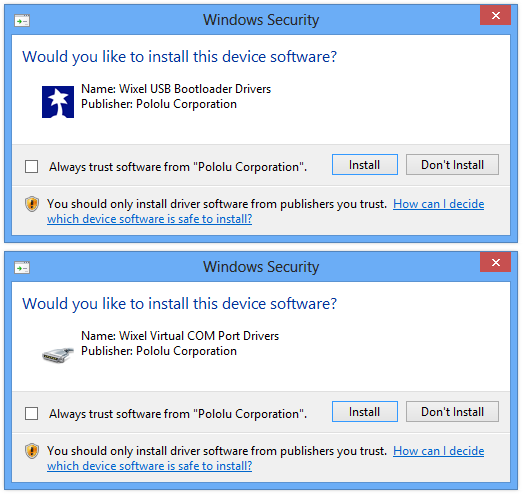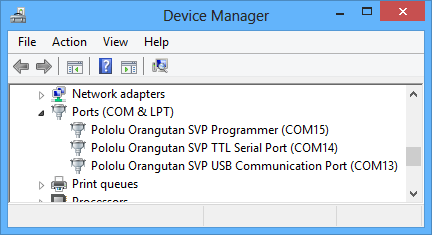If you use Windows XP, you will need to have either Service Pack 3 or Hotfix KB918365 installed before installing the drivers for the Pololu USB AVR programmer. Some users who installed the hotfix have reported problems using the programmer which were solved by upgrading to Service Pack 3, so we recommend Service Pack 3 over the hotfix.
Please note that these drivers will only work for the original version of the Pololu USB AVR Programmer (Pololu item #1300), not the newer Pololu USB AVR Programmer v2. If you have one of the newer v2.x programmers, which have blue PCBs instead of green, you will need to install the drivers specific to those.
Before you connect your Pololu USB AVR programmer to a computer running Microsoft Windows, you must install its drivers:
- Download and install the Pololu AVR Development Bundle (~11 MB exe). This includes the drivers and software for the Pololu USB AVR Programmer, along with the Pololu AVR C/C++ Library and the Orangutan SVP Drivers. If you are not sure which of these components you need, it is OK to install all of them. If you only need to install the drivers and software for the programmer, you can download those separately: USB AVR Programmer Windows Drivers and Software (11MB exe).
- During the installation, Windows will ask you if you want to install the drivers. Click “Install” (Windows 10, 8, 7, and Vista) or “Continue Anyway” (Windows XP).
Bring up drivers. USB Function driver bring-up is only required if you support USB Function mode. If you previously implemented a USB Function driver for a USB micro-B connector, describe the appropriate connectors as USB Type-C in the ACPI tables for the USB Function driver to continue working. A storage device must be accessible and should be able to copy a file 200MB or more in size. If the device has multiple functions, such as scan & print, make sure to test both the scan and print functionality. If the device is a USB Type-C device, confirm that the applicable USB and alternate modes are functional. Using ETW to log issues. Hi, I have the 391 usb to comport unit connected to a windows 10 platform. I can not install the driver correctly (using the “pololu-cp2102-setup-x64.exe”) as the I get this message: ' The current language is not supported by the device driver installation wizard. Contact the vendor that provided you this package.' If I place windows in “testsigning” (from a prompt: bcdedit -set. After installing the drivers and plugging in an A-Star, in the “Ports (COM & LPT)” category of the Device Manager, you should see a COM port for the A-Star’s running sketch named “Pololu A-Star 32U4”. You might see that the COM port is named “USB Serial Device” in the Device Manager instead of having a descriptive name.

Windows 10, Windows 8, Windows 7, and Windows Vista users: After the installation has finished, your computer should automatically install the necessary drivers when you connect a Pololu USB AVR programmer, in which case no further action from you is required.
Windows XP users: After the installation has finished, follow steps 3-7 for each new Pololu USB AVR programmer you connect to your computer.

- Connect the USB AVR programmer to your computer’s USB port. The programmer is actually three devices in one so your XP computer will detect all three of those new devices and display the “Found New Hardware Wizard” three times. Each time the “Found New Hardware Wizard” pops up, follow steps 4-7.
- When the “Found New Hardware Wizard” is displayed, select “No, not this time” and click “Next”.

- On the second screen of the “Found New Hardware Wizard”, select “Install the software automatically” and click “Next”.
- Windows XP will warn you again that the driver has not been tested by Microsoft and recommend that you stop the installation. Click “Continue Anyway”.
- When you have finished the “Found New Hardware Wizard”, click “Finish”. After that, another wizard will pop up. You will see a total of three wizards when plugging in the programmer. Follow steps 4-7 for each wizard.
If you use Windows XP and experience problems installing the serial port drivers, the cause of your problems might be a bug in older versions of Microsoft’s usb-to-serial driver usbser.sys. Versions of this driver prior to version 5.1.2600.2930 will not work with the USB AVR programmer. You can check what version of this driver you have by looking in the “Details” tab of the “Properties” window for C:WindowsSystem32driversusbser.sys. To get the fixed version of the driver, you will need to either install Service Pack 3 or Hotfix KB918365. Some users who installed the hotfix have reported problems using the programmer which were solved by upgrading to Service Pack 3, so we recommend Service Pack 3 over the hotfix.
After installing the drivers, if you go to your computer’s Device Manager and expand the “Ports (COM & LPT)” list, you should see two COM ports: “Pololu USB AVR Programmer Programming Port” and “Pololu USB AVR Programmer TTL Serial Port”. In parentheses after these names, you will see the name of the port (e.g. “COM3” or “COM4”). If you expand the “Pololu USB Devices” list you should see an entry for the Pololu USB AVR programmer.
Pololu Port Devices Drivers
Windows XP device manager showing the Pololu USB AVR Programmer |
|---|
Windows 8 device manager showing the Pololu USB AVR Programmer |
|---|

Pololu Port Devices Driver Updater
The COM ports in the Device Manager might actually be named “USB Serial Device” instead of having a descriptive name as shown in the screenshots above. This can happen if you are using Windows 10 or later and you plugged the programmer into your computer before installing our drivers for it. In that case, Windows will set up your programmer using usbser.inf, a driver from Microsoft that ships with Windows 10 and later, and it will display “USB Serial Device” as the name for each port. The ports will be usable, but it will be hard to distinguish the ports from each other because of the generic name shown in the Device Manager. We recommend fixing the names in the Device Manager by right-clicking on each “USB Serial Device” entry, selecting “Update Driver Software…”, and then selecting “Search automatically for updated driver software”. Windows should find the drivers you already installed, which contain the correct name for the port.
Some software will not allow connection to higher COM port numbers. In particular, AVR Studio and early versions of Atmel Studio cannot connect to ports higher than COM9. If you need to change the COM port number assigned to your programmer, you can do so using the Device Manager. Double-click the COM port to open the properties dialog, and click the “Advanced…” button in the “Port Settings” tab. From this dialog you can change the COM port assigned to the programmer.
Pololu Port Devices Driver Device
Once your have successfully installed the device drivers and software, you can run the Pololu USB AVR Programmer Configuration Utility, which is available in the Start menu in the Pololu folder. This application allows you to change many of the settings of your programmer and can help troubleshoot problems. Please see Section 3.e for more information.
This software package also contains the installation files for the Pololu SLO-scope application for Windows. Please see Section 7 for usage instructions.
Related products

Pololu Port Devices Driver
| Pololu USB AVR Programmer |
| Orangutan SV-328 + USB Programmer Combo |
| Orangutan LV-168 + USB Programmer Combo |
| Baby Orangutan B-328 + USB AVR Programmer Combo |
| Baby Orangutan B-48 + USB Programmer Combo |
